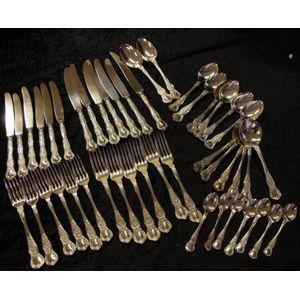Art Deco Sterling Silver Flatware Set with Bone Handles
You must be a subscriber, and be logged in to view price and dealer details.
Subscribe Now to view actual auction price for this item
When you subscribe, you have the option of setting the currency in which to display prices to $Au, $US, $NZ or Stg.
- Flatware - An alternative name for items of cutlery, principally knives, forks and spoons, now generally used to describe sets of these implements. Nowadays it is mostly used when describing cutlery made of silver and silver plate.
It is less frequently used to describe all "flat' items of tableware, so that as well as cutlery the definition includes plates. - Sterling Silver - Sterling silver is a mixture of 92.5% pure silver and 7.5% of another metal, usually copper. Fine silver is 99.9% pure silver, and is relatively soft and the addition of the very small amount of copper gives the metal enough strength and hardness to be worked into jewellery, decorative and household objects.
- Art Deco Period - The Art Deco period was a cultural movement that emerged in the 1920s and 1930s, and was characterized by its emphasis on modernism, luxury, and elegance. The name "Art Deco" comes from the Exposition Internationale des Arts Décoratifs et Industriels Modernes, a large exhibition held in Paris in 1925 that showcased the latest trends in decorative arts.
Art Deco was a reaction against the ornate and elaborate styles of the previous era, and reflected a new modern sensibility. It was characterized by streamlined, geometric shapes, bright colours, and the use of new materials such as chrome, glass, and Bakelite. Art Deco designers sought to create a sense of luxury and sophistication, often incorporating expensive materials such as ivory, marble, and rare woods.
Art Deco had a significant impact on a wide range of artistic fields, including architecture, fashion, graphic design, and interior design. Some of the most iconic examples of Art Deco architecture include the Empire State Building in New York City, the Hoover Building in London, and the Palais de Chaillot in Paris.
The Art Deco period came to an end in the 1940s, as World War II and changing cultural trends led to a shift in artistic styles. However, Art Deco remains an important influence on design and art, and continues to be celebrated for its modernist sensibility and glamorous aesthetic.
This item has been included into following indexes:
Visually similar items

Twelve person sterling silver Hanoverian cutlery service, of 127 pieces individually stamped 925/1000 sterling 1919 Pat Shreve, Treat and Eacret, including knives

Rodd silver plated cutlery service, comprising 6 main knives, 6 entree knives,6 main forks, 6 entree forks, 6 soup spoons, 6 dessert spoons, 6 tea spoons, a bread knife, & 2 serving spoons

A Danish 830 silver Carl M. Cohr 27pcs, Diana part flatware set, circa 1940's, comprising of 8 table knives (stainless blades), 8 dinner forks, 8 table spoons, 2 serving spoons, 1 ladle stamped with ' cmC' monogram, Carl M Cohr, Fredericia, Copenhagen and

12 silver soup spoons and 12 silver dinner forks, of similar fiddle patterns, some bearing a crest. 1760 gms
